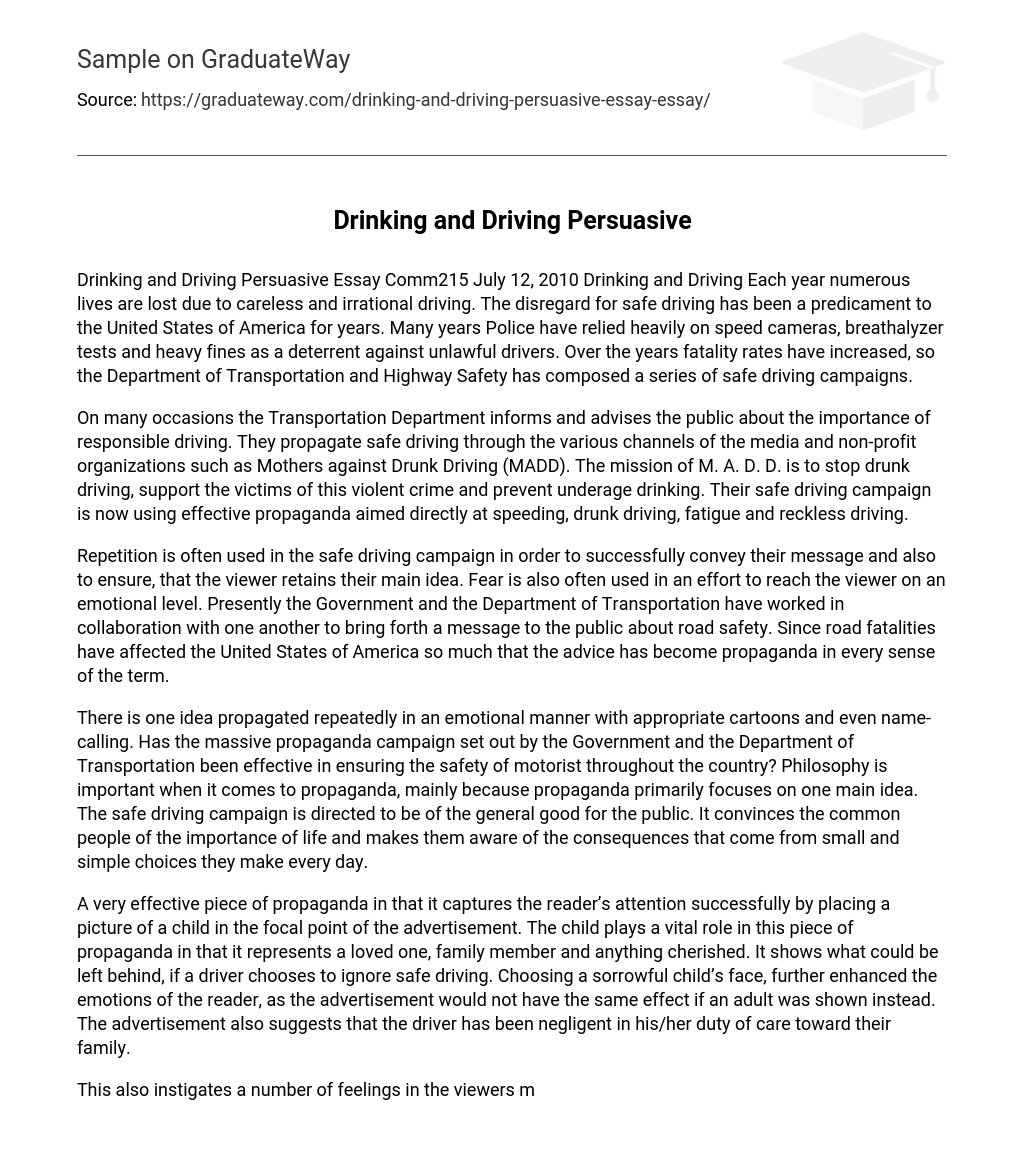Each year numerous lives are lost due to careless and irrational driving. The disregard for safe driving has been a predicament to the United States of America for years. Many years Police have relied heavily on speed cameras, breathalyzer tests and heavy fines as a deterrent against unlawful drivers. Over the years fatality rates have increased, so the Department of Transportation and Highway Safety has composed a series of safe driving campaigns.
On many occasions the Transportation Department informs and advises the public about the importance of responsible driving. They propagate safe driving through the various channels of the media and non-profit organizations such as Mothers against Drunk Driving (MADD). The mission of M. A. D. D. is to stop drunk driving, support the victims of this violent crime and prevent underage drinking. Their safe driving campaign is now using effective propaganda aimed directly at speeding, drunk driving, fatigue and reckless driving.
Repetition is often used in the safe driving campaign in order to successfully convey their message and also to ensure, that the viewer retains their main idea. Fear is also often used in an effort to reach the viewer on an emotional level. Presently the Government and the Department of Transportation have worked in collaboration with one another to bring forth a message to the public about road safety. Since road fatalities have affected the United States of America so much that the advice has become propaganda in every sense of the term.
There is one idea propagated repeatedly in an emotional manner with appropriate cartoons and even name-calling. Has the massive propaganda campaign set out by the Government and the Department of Transportation been effective in ensuring the safety of motorist throughout the country? Philosophy is important when it comes to propaganda, mainly because propaganda primarily focuses on one main idea. The safe driving campaign is directed to be of the general good for the public. It convinces the common people of the importance of life and makes them aware of the consequences that come from small and simple choices they make every day.
A very effective piece of propaganda in that it captures the reader’s attention successfully by placing a picture of a child in the focal point of the advertisement. The child plays a vital role in this piece of propaganda in that it represents a loved one, family member and anything cherished. It shows what could be left behind, if a driver chooses to ignore safe driving. Choosing a sorrowful child’s face, further enhanced the emotions of the reader, as the advertisement would not have the same effect if an adult was shown instead. The advertisement also suggests that the driver has been negligent in his/her duty of care toward their family.
This also instigates a number of feelings in the viewers mind about their family, and the result to their loved ones. Fear is also generated in this piece of propaganda in that it plays on the emotions of the viewer by making them aware of what may be left behind if they die by a thoughtless and preventable accident. This further prompts safe driving, that it reveals to the viewer real life accidents, and promotes concern to the viewer. It also gives a sense of pity for the child that has been abandon by its deceased parents. This is a typical propaganda article which relies heavily on the emotions of the viewer to convey its message.
It first projects scenes of typical Christmas events which then suddenly are replaced by horrific automobile accidents. Its effectiveness is further enhanced as the Christmas scenes aroused the emotions of the viewer. This would be a time when the accident scenes would influence the viewer the most. This affects the viewer differently from the previous piece of propaganda in that it reveals the aftermath of real road accidents. The viewer would presumably be distressed by the propaganda, therefore influencing the viewer towards safer driving.
This piece of propaganda subconsciously promotes the simple problem, solution, and technique. According to M. A. D. D (Mothers against Drunk Driving) In 2008, an estimated 11,773 people died in alcohol-impaired traffic crashes. Three in every 10 Americans will be involved in an alcohol-related crash in their lives. The problem being drunk and driving and solution being easy don’t drink and drive. The road fatality rate has amplified so dramatically that increased speed cameras on traffic lights and breathalyzer tests are being inputted into the highways and streets.
With the ongoing safe driving propaganda the Government and Department of Transportation inputted, road fatalities are still continuing. So therefore how can the safe driving campaign have been effective in ensuring the safety of motorists? The safe driving campaign was effective in that it followed the usual norms of propaganda. The campaign was effective in influencing motorists to drive in a more-safe manner, thou it takes time to be accepted and understood by the general public.
References
- Mothers against drunk driving. (n. d. ) MADD: activism /victim services /education. Retrieved from http://www. madd. org





